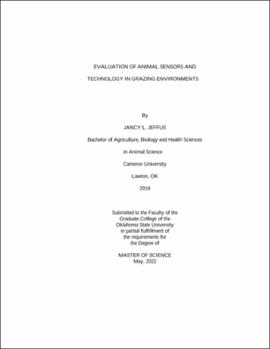| dc.description.abstract | The object of the first experiments were to determine the effects of virtual fencing on cortisol concentrations and behavior of beef cattle. Mixed breed beef heifers and cows (n = 55 and 59, respectively; initial BW = 315 ± 30 kg and 484 ± 84 kg, respectively) were randomly assigned to a physically fenced (PF) or virtually fenced (VF) pasture. Animals were rotated within respective treatments for 28 or 56 d, respectively. No significant differences were observed in animal behaviors, cortisol concentrations in hair or feces, nor lactate and non-esterified fatty acid concentrations. Virtual fencing was not more stressful to animals when compared to electric fencing. The objective of the second experiment was to validate the classification of the activities, and resource, terrace position, and burn unit usage of grazing cattle made by remote monitoring collars. Angus steers (n = 12; BW = 227 ± 45.0 kg) were fitted with an electronic GPS receiver and activity collar (Herd MOOnitor Ltd). Animal activities (collected every 4 s) were determined by a real time microcontroller and an algorithm for analyzing accelerometer data, and GPS locations (collected every 5 min) were collected and classified by the collar. Animal activities included grazing, walking, and resting. GPS locations included position on terraces, burn patch, and resource utilized. Data from the collars were matched to human observation data measuring the same activity and location parameters. Data from walking and resting activities, and resource and burn patch usage were accurately matched. However, grazing activity classification (≥30%) and terrace position accuracies (≥39%) were less than the reported NIR (≥39% and ≥42%, respectively), leading researchers to conclude that grazing activities could not be accurately classified. | |
